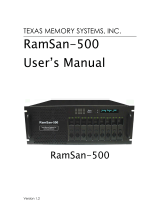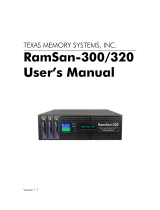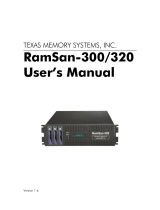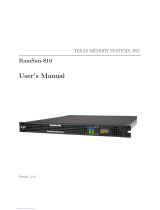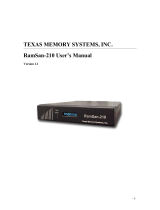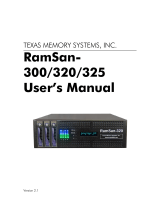Page is loading ...

The 4Gb HBA of Choice
In Oracle Environments
QLogic vs. Emulex 4Gb Fibre Channel HBA
Performance Benchmarking with Oracle
Workloads
Executive Summary
Today’s mission-critical Online Transaction Processing (OLTP), Online Analytical Processing
(OLAP) and Web applications demand the highest levels of performance from their database
servers and storage infrastructure. To satisfy this demand, organizations are making the transition
to 4Gb Fibre Channel SANs, and IT decision makers are under pressure to select the right
components in order to ensure a cost-effective and scalable solution.
A critical element of overall SAN performance is the selection and deployment of a Host Bus
Adapter (HBA) with the right architecture. With the introduction of multi-processor CPUs coupled
with virtualization technologies, high performance database solutions need to be complemented
with high performance and scalable IO connectivity. A wrong choice can result in management
complexity and limit an organization’s overall business agility to meet continually evolving business
needs.
To help IT decision makers make the best, most informed HBA choice, QLogic has performed a
series of head-to-head performance benchmarks showing the I/O performance and scalability
advantages of the QLogic SANblade™ Pro 2400 series HBAs over Emulex® LightPulse® HBAs in
a variety of real-world OLTP, OLAP and Web scenarios using SAN-attached Oracle databases.
QLogic compared the overall performance of the 4Gb HBAs when attached to industry leading
storage arrays and solid state drives to emulate a real-world SAN with maximum throughput
workloads. Our tests highlight the advantage delivered by QLogic’s SAN Pro architecture in
Oracle environments.
Key Findings
For demanding enterprise database applications
, choosing QLogic 4Gb FC HBAs provides:
• 33% Higher Performance
• Using best-in-class Oracle™ and EMC™ components in OLTP, Web and
OLAP workloads indicative of real-world storage configurations, QLogic HBAs
demonstrated 33% better throughput than Emulex HBAs.
• 28% Superior Scalability
• In high-performance database applications, emulated with Oracle workloads,
QLogic’s SANblade 2400 series dual port HBAs deliver 28% higher IOPs
compared to the Emulex’s 11000 series HBAs.

2 QLogic vs. Emulex HBA Performance Benchmarking with Oracle Workloads
WP06005 SN0032007-00 A
Introduction
The objective of this exercise was to test and compare the I/O performance of QLogic and
Emulex 4Gb Fibre Channel HBAs in a representative selection of database-driven
workloads, a configuration arrived at through a combination of customer requests as well as
common reference within Oracle user groups.
• An OLTP workload with a read:write ratio of 70:30
• OLTP applications are high throughput, insert/update-intensive and typical
for companies having large transaction processing applications, such as
airline ticketing, large order-entry, and banking applications.
• A Web workload with read:write ratio of 90:10
• Most database-backed Web applications have high throughput
requirements and are read-intensive, but not exclusively so. Web
workloads mix a variety of content and data-rich applications ranging from
e-commerce and banking applications to CRM and self-service intranet
applications.
• An OLAP workload with a read:write ratio of 100:0
• The typical applications of OLAP are in business reporting for sales,
marketing, business performance management (BPM), budgeting and
forecasting, financial reporting and planning.
For our tests, the key measures of HBA I/O performance, especially when used in a
database application, were one of the following:
• The ability to handle multiple data requests, and the volume of data or throughput
as measured in megabytes per second (MBps) with an increase in the number of
outstanding IOs.
• The ability of the HBA to scale across multiple ports.
In order to make the benchmarks relevant to today’s businesses, we selected the market-
leading Oracle® RDBMS running on Microsoft® Windows 2003™ Enterprise Edition with
Service Pack 1. This is a very popular, highly scalable enterprise configuration in wide
production use for all three workloads mentioned above. Selecting Oracle also allowed us
to use ORION, a tool from Oracle used for predicting the performance of the Oracle
database under load. ORION does this by simulating database I/O workloads using the
same I/O software stack as the RDBMS. This tool gives users the capability to decide the
kind and amount of load, varying from small sequential and random with user-defined data
blocks.
Testing performance - To test the real-world performance of the HBAs, indicative of use
within small or medium scale enterprises, we used a market-leading EMC Clariion
CX300™ storage array.
Testing scalability - To test the maximum throughput of the HBAs, we also conducted the
test using a Texas Memory Systems RamSan-400™ solid-state storage subsystem.
Solid-state storage dramatically reduces the latency that comes from using disk-based
storage, allowing us to measure the true horse-power of the HBA.

3 QLogic vs. Emulex HBA Performance Benchmarking with Oracle Workloads
WP06005 SN0032007-00 A
Performance Scalability with Oracle Workloads
Test Setup
The test setup consisted of the latest QLogic SANblade™ Pro 2400 series and Emulex®
LightPulse® HBAs running on the latest commercially available drivers, housed in a Dell®
PowerEdge™ 6850 server running Windows® Server™ 2003 operating system. The Dell
server was connected to an enterprise storage array with 15 disks of 10,000 rpm total
capacity through a QLogic® SANbox™ 5600 series 4Gbps switch.
The testing utilized one port on the enterprise storage array, accessing 8 of the total 15
LUNs created. Figure 1 depicts the test configuration setup.
Figure 1: Test Setup
All tests were run using the HBA default settings from both companies.
Test Procedure
The test procedure using an enterprise storage array was as follows:
1. A QLogic 4Gb PCI Express to Fibre Channel HBA (QLE2460) was installed on the
test server using the appropriate STORport miniport driver.
2. Eight LUNs of 60 GB each were created on the enterprise storage array and
mapped to the first port.
3. The Windows device manager was used to verify that the LUN(s) were visible.
Each LUN was then formatted and assigned a drive letter which could be used by
the ORION tool.
4. The ORION commands were executed to simulate the three main workloads, using
a standard block size of 1 megabyte:
QLogic SANblade
2400 series HBA
Emulex Lightpulse
11000 series HBA
Dell PE 6850 Server
QLogic SANBOX 5600 4 Gbps
FC switch
Enterprise storage array

4 QLogic vs. Emulex HBA Performance Benchmarking with Oracle Workloads
WP06005 SN0032007-00 A
1. OLTP
2. Web application
3. OLAP
5. The same steps were repeated for the Emulex 4Gb PCI Express to FC HBA
(LPe11000).
Test Results
Performance of the QLogic and Emulex HBAs was measured based on a critical parameter
- the rate at which the data is parsed by the HBAs (megabytes per second, or MBps).
Higher MBps values denote greater throughput and a higher level of performance.
The results demonstrate that across all three workloads—OLTP, OLAP, and Web—
QLogic’s performance was an average 31% better than Emulex.
The performance was measured against an increasing load on the HBAs determined by
number of outstanding Input-Output (I/Os) requests. All tests used a standard block size of
1 megabyte.
Note that the performance gap between
QLogic and Emulex increases as the
number of Outstanding I/Os increases.
(The # of Outstanding I/Os specifies the
maximum number of outstanding
asynchronous I/O operations active at one
time).
OLAP Workload Web Workload
20
60
100
140
1 2 3 4 5 6 7 8 9 10111213141516
No of Outstanding I/Os
MBPs
QLogic Em u le x
20
60
100
140
180
1 2 3 4 5 6 7 8 9 10 11 12 13 14 15 16
No of Outstanding I/Os
MBPs
QLogic Em u l e x
20
60
100
140
1 2 3 4 5 6 7 8 9 10 11 12 13 14 15 16
No of Outstanding I/Os
MBPs
QLogic Em u l e x
27%
Higher
33 %
Higher
OLTP Workload
33 %
Higher

5 QLogic vs. Emulex HBA Performance Benchmarking with Oracle Workloads
WP06005 SN0032007-00 A
Dual Port Scalability with Oracle Workloads
Test Setup
The test setup consisted of the latest 4Gb HBAs from QLogic and Emulex, running on
current commercially available drivers, housed in a Dell® PowerEdge™ 6850 server
running Windows® Server™ 2003 operating system. The Dell server was connected to a
RamSan-400 with 32 GB total capacity through a QLogic® SANbox™ 5600 series 4Gbps
switch. Using a solid state disk allows you to remove the latency introduced by slower disk-
driver and future proof the performance benchmark expected from next-generation storage
arrays.
Two LUNs of 16 GB each were created on the RamSan, visible through two different ports.
The switch was zoned so that each LUN was visible through its respective port on the HBA.
Figure 2: Test Setup to Measure Scalability
The tests were performed using the latest hardware, software and drivers that were
commercially available at the time of testing. All tests were run using the HBA default
settings from both companies
Test Procedure
The test procedure using RamSan-400 solid state storage was as follows:
1. A QLogic 4Gb dual channel PCI Express to Fibre Channel HBA (QLE2462) was
installed on the test server using the appropriate miniport driver.
2. Two LUNS of 16GB each were created and mapped to two different ports.
3. The Windows device manager was used to verify that the LUN(s) were visible.
Each LUN was then formatted and assigned a drive letter which could be used by
the ORION tool.
4. The ORION commands were executed to simulate an OLTP workload.
QLogic SANblade
2400 series HBA
Emulex Lightpulse
11000 series HBA
Dell PE 6850 Server
QLogic SANBOX 5600 4 Gbps
FC switch
Texas Memory
System RamSan 400

6 QLogic vs. Emulex HBA Performance Benchmarking with Oracle Workloads
WP06005 SN0032007-00 A
5. The same steps were repeated for the Emulex 4gb dual channel PCI Express to
Fibre Channel HBA (LPe11002).
Test Results
To test the scalability of QLogic and Emulex HBAs, a set of OLTP tests were run using the
RamSan configuration as described above, using dual port HBAs. OLTP is the most
common workload in the enterprise giving a good indication of the HBA’s scalability in a
production setting. Performance of the QLogic and Emulex HBAs was measured using a
critical parameter - the rate at which I/O requests are serviced (IOPs). Higher IOP values
denote greater throughput, and a higher level of performance.
Dual Port Scalability
The performance difference between
QLogic and Emulex HBA widens as the
outstanding IO load increases,
averaging 28%.
Linear Scalability across Dual Ports
5000
15000
25000
35000
45000
12348121620242832364044485256606468727680
IOps
QLogic port 1 Em ule x por t 1
QLogic port 2 Em ule x por t 2
28%
Higher
30000
34000
38000
42000
Port 1 Port 2
IOPS
QLogic Emulex
28%
Higher
No of Outstanding IO’s

7 QLogic vs. Emulex HBA Performance Benchmarking with Oracle Workloads
WP06005 SN0032007-00 A
Summary and Conclusion
IT managers know that choosing the right HBA for their SAN infrastructure can have a
strong impact on the performance, agility and scalability of their enterprise storage
environments.
The results of this study demonstrate that QLogic SANblade™ Pro 2400 series HBAs
consistently out-perform Emulex® LightPulse® HBAs in today’s real-world environments
and provide significant head-room for future scalability.
• Higher Performance: Using best-in-class Oracle™ and EMC™ components in
OLTP, Web and OLAP workloads indicative of real-world storage configurations,
QLogic HBAs demonstrated 31% better throughput than Emulex HBAs.
• Superior Scalability: QLogic’s dual port HBAs scale better in OLTP tests with
higher work-loads and deliver 28% higher IOPs compared to Emulex HBAs.
The key to the increased performance advantage can be attributed to the SAN Pro
architecture that is designed into QLogic 4Gb FC ASICs and HBAs. Some of the key
Performance Foundations of the SAN Pro architecture include:
Intelligent Interleaved
Direct Memory Access
(iiDMA) – ensures
maximum bandwidth
utilization between end
nodes that have different
link rates.
Dual Read Direct
Memory Access
(DRDMA) – optimizes
DMA read request
processing by allowing
multiple DMA read
requests to be serviced.
Out of Order Frame
Reassembly (OoOFR) –
reassembles the frames
within an exchange in the
correct order, even though
they may have been
received out of order
Please refer to the URL below for Technical Briefs on the foundations of the SAN Pro
architecture.
http://www.qlogic.com/knowledgecenter/briefs_papers.asp

8 QLogic vs. Emulex HBA Performance Benchmarking with Oracle Workloads
WP06005 SN0032007-00 A
The superior scalability advantages demonstrated in this testing delivers practical benefits
in real-life applications used by enterprise IT users:
• Lower the hardware total cost of ownership (TCO) especially with emerging,
high-performance database applications that will be used in conjunction with
emerging server virtualization technologies and high-performance Grid-computing.
QLogic HBAs provide higher IOPs and throughput to account for high bandwidth
requirements to meet the needs of enterprise SANs.
• Investment protection. Future proof SAN infrastructure in the data center with
higher performance 4Gb QLogic HBAs. Higher performance and scalability,
backward and forward compatibility are being delivered at the price of 2Gb FC HBA
technology.
• Deliver true performance advantages in enterprise email and database
applications such as Microsoft Exchange and Oracle. For more information on
QLogic 4Gb FC HBA performance advantages in a Microsoft Exchange
environment, please check out the following URL.
http://www.qlogic.com/products/indep_test_results.asp
Standardizing on and deploying QLogic 4Gb HBAs translates to a clear performance
benefit, enabling enterprises to do more with less and drive more value from their SAN
infrastructure investments.

9 QLogic vs. Emulex HBA Performance Benchmarking with Oracle Workloads
WP06005 SN0032007-00 A
Appendix
Server Configuration
Intel Server
Type and Speed of Processor
X86 Family Intel Xeon quad
processor running at 3.6 GHz
Memory 8Gb SDRAM
Internal Hard Disk 140 GB
Operating System (OS) MS Windows Server 2003 Enterprise
Edition
OS Version 5.2.3790 Service Pack 1
System Model Dell Power Edge 6850
FC HBA Configuration
QLogic and Emulex FC HBA
QLogic Driver STOR miniport
QLogic Driver Version 9.1.2.16
Emulex Driver STOR miniport
Emulex Driver Version 1.11a3
External Storage Configuration
EMC Storage
Disk Array EMC Clariion CX300
Number of Drives 15 10K rpm
Number of LUN’s 15
Drives per LUN 1
Number of Ports Used 2
RamSan Storage
Model RamSan 400
Total Storage Capacity 32 GB
Number of Ports Used 1/2 Port
Switch Configuration
Switch Configuration
Switch SANbox 5600
Vendor QLogic
Total Number/Speed of Ports 16 4Gb
Firmware Version V5.0.0.17.0

10 QLogic vs. Emulex HBA Performance Benchmarking with Oracle Workloads
WP06005 SN0032007-00 A
References
1)
ORION download and documentation is available at:
http://www.oracle.com/technology/software/tech/orion/index.html
2) QLogic drivers are available at:
http://support.QLogic.com/support/os_detail.asp?productid=935&osid=85
3)
Emulex drivers are available at:
http://www.emulex.com/ts/downloads/stor/storport.html
Disclaimer
Reasonable efforts have been made to ensure the validity and accuracy of these comparative
performance tests. QLogic Corporation is not liable for any error in this published white paper or the
results thereof. Variation in results may be a result of change in configuration or in the environment.
QLogic specifically disclaims any warranty, expressed or implied, relating to the test results and their
accuracy, analysis, completeness or quality
.
/
